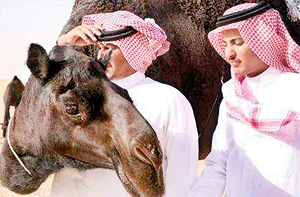Sunday Times 2
Camels become prime suspects in deadly Saudi virus outbreak
View(s):LONDON (Reuters) – People infected with a deadly virus that emerged in Saudi Arabia last year may have caught it from one-humped camels used in the region for meat, milk, transport and racing. In a study into what kind of animal “reservoir” may be fuelling the outbreak in humans, scientists said they had found strong evidence it is widespread among dromedary camels in the Middle East.
The Middle East Respiratory Syndrome Coronavirus (MERS-CoV), which can cause coughing, fever and pneumonia, has been reported in people in the Gulf, France, Germany, Italy, Tunisia and Britain.

Saudis stand near a camel during the Mazayen al-Ibl competition to find the ''most beautiful camels'' (REUTERS)
The World Health Organization (WHO) says 46 people have died out of a total 94 confirmed cases, the majority in Saudi Arabia.
“As new human cases of MERS-CoV continue to emerge, without any clues about the sources of infection except for people who caught it from other patients, these new results suggest that dromedary camels may be one reservoir,” said Chantal Reusken of the National Institute for Public Health and the Environment in Bilthoven, the Netherlands, who led the study.
“There are different types of contact of humans with these animals that could lead to transmission of a virus.” Experts not involved in the study hailed its findings as a major step towards solving the mystery of the MERS virus and, ultimately, controlling it.
The WHO welcomed the study but said it had not provided any insight into how humans become infected. Most people with the disease became infected through contact with other people, while most of those not infected by other humans did not have contact with camels either, WHO spokesman Tarik Jasarevic said.
“What this study has shown is antibodies in the camels, that means that camels have been infected at some point in time and that produced antibodies,” he told a news briefing in Geneva on Friday. “Now, to be sure that this is the same MERS coronavirus as it is in humans, we need to find the virus itself, not antibodies. So this would be the next step, to find the virus and identify it as the same one.”
Other animal species may also be infected, he said.
“So basically it gives us some clue and direction to go but we still don’t know what is the source of the virus and most importantly we still don’t know what kind of exposure makes humans (become) infected,” Jasarevic said. Days after identifying the new virus in September in a Qatari patient at a London hospital, British scientists had sequenced part of its genome, mapped out its “phylogenetic tree” and found it was related to a virus found in bats.
Further work by a scientists at Germany’s University of Bonn suggested it may have come through an intermediary animal after they conducted a detailed case study of a male patient from Qatar who said he owned a camel and a goat farm.
“The biggest mysteries … have been how people are becoming infected with a virus of bats, and why it is happening in the Middle East. By showing that one-humped camels have a history of MERS-like infections, these scientists may have helped answer both questions at once.”
Follow @timesonlinelk
comments powered by Disqus

